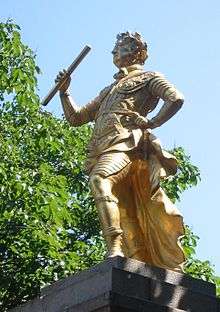Saint Helier
Saint Helier (/ˈhɛliər/; French: Saint-Hélier; Norman: Saint Hélyi) is one of the twelve parishes of Jersey, the largest of the Channel Islands in the English Channel. St Helier has a population of about 33,500, roughly 34.2% of the total population of Jersey, and is the capital of the island (although Government House is situated in St Saviour). The urban area of the parish of St Helier makes up most of the largest town in Jersey, although some of the town area is situated in adjacent St Saviour, with suburbs sprawling into St Lawrence and St Clement. The greater part of St Helier is rural.
Saint Helier | |
|---|---|
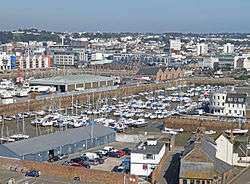 Saint Helier viewed across the Old Harbour | |
 Flag .svg.png) Coat of arms | |
 Location of Saint Helier Saint-Hélier in Jersey | |
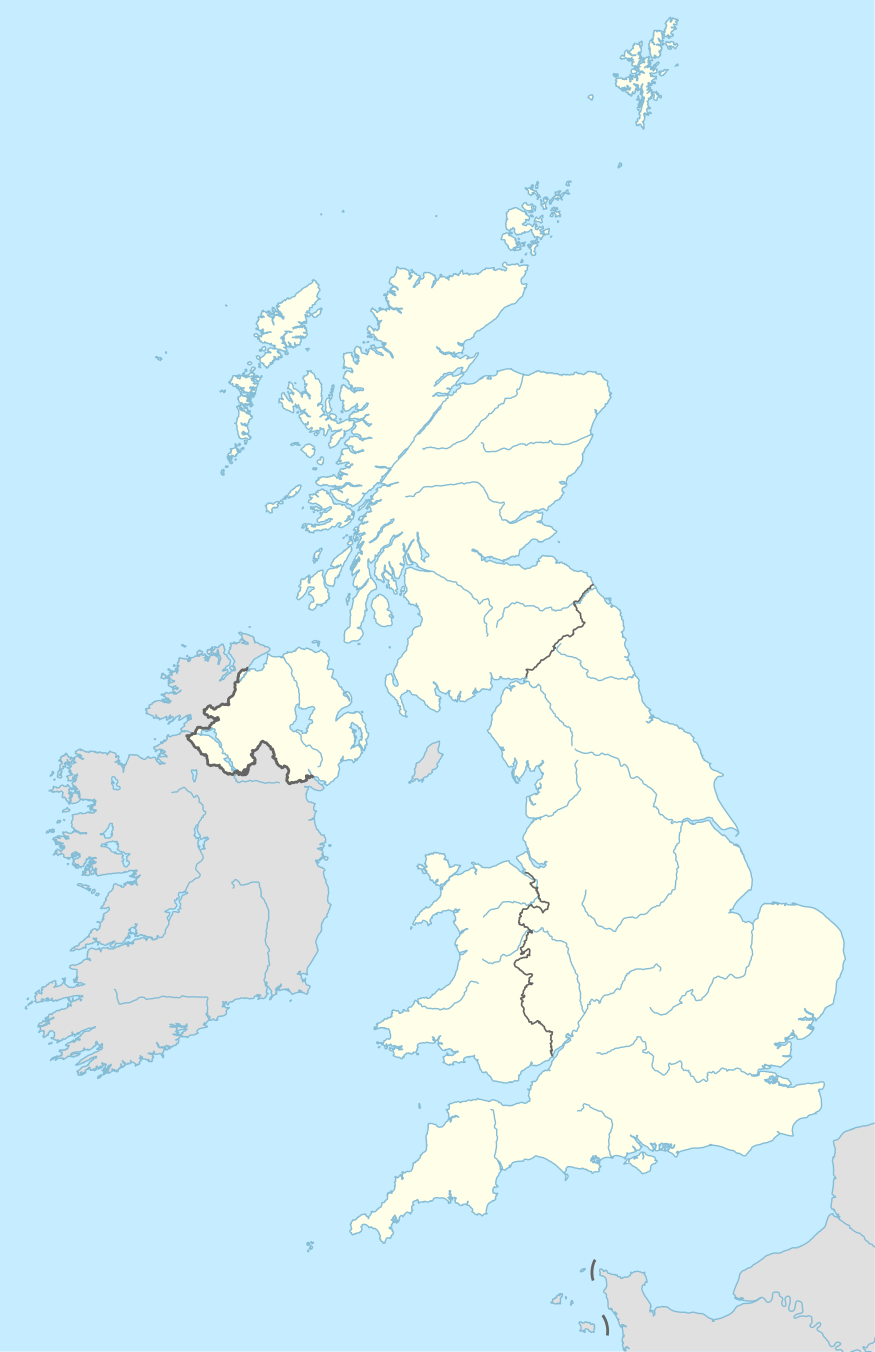 Saint Helier Location of Saint Helier Saint-Hélier in Jersey | |
| Coordinates: 49.187°N 2.107°W | |
| Crown Dependency | Jersey, Channel Islands |
| Government | |
| • Connétable | Simon Crowcroft |
| Area | |
| • Total | 10.6 km2 (4.1 sq mi) |
| Area rank | Ranked 5th |
| Population (2011) | |
| • Total | 33,500 |
| • Density | 3,200/km2 (8,200/sq mi) |
| Time zone | GMT |
| • Summer (DST) | UTC+01 |
| Postcode district | |
| Postcode sector | 3 and 4 |
| Website | www.sthelier.je |
The parish covers a surface area of 4.1 square miles (10.6 km2), being 9% of the total land area of the island (this includes reclaimed land area of 494 acres (2.00 km2) or 200 ha).
The parish arms are two crossed gold axes on a blue background, the blue symbolising the sea, and the axes symbolising the martyrdom of Helier at the hands of Saxon pirates in 555 AD.
History

It is thought that the site of St Helier was settled at the time of the Roman control of Gaul.
The medieval hagiographies of Helier, the patron saint martyred in Jersey and after whom the parish and town are named, suggest a picture of a small fishing village on the dunes between the marshy land behind and the high-water mark.
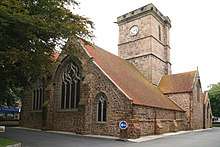
Although the Parish Church of St Helier is now some considerable distance from the sea, at the time of its original construction it was on the edge of the dunes at the closest practical point to the offshore islet called the Hermitage (site of Helier's witness and martyrdom). Before land reclamation and port construction started, boats could be tied up to the churchyard wall on the seaward side.
An Abbey of St Helier was founded in 1155 on L'Islet, a tidal island adjacent to the Hermitage. Closed at the Reformation, the site of the abbey was fortified to create the castle that replaced Mont Orgueil as the island's major fortress. The new Elizabeth Castle was named after the Queen by the Governor of Jersey 1600–1603, Sir Walter Raleigh.
18th century
Until the end of the 18th century, the town consisted chiefly of a string of houses, shops and warehouses stretching along the coastal dunes either side of the Church of St Helier and the adjacent marketplace (since 1751, Royal Square). La Cohue (a Norman word for courthouse) stood on one side of the square, now rebuilt as the Royal Court and States Chamber (called collectively the States Building). The market cross in the centre of the square was pulled down at the Reformation, and the iron cage for holding prisoners was replaced by a prison gatehouse at the western edge of town.
George II gave £200 towards the construction of a new harbour - previously boats would be beached on a falling tide and unloaded by cart across the sands. A statue of the king by John Cheere was erected in the square in 1751 in gratitude, and the market place was renamed Royal Square, although the name has remained Lé Vièr Marchi (the old market) to this day in Jèrriais. Many of St Helier's road names and street names are bilingual English/French or English/Jèrriais, but some have only one name. The names in the various languages are not usually translations: distinct naming traditions survive alongside each other.
The Royal Square was also the scene of the Battle of Jersey on 6 January 1781, the last attempt by French forces to seize Jersey. John Singleton Copley's epic painting The Death of Major Pierson captures an imaginative version of the scene.
As harbour construction moved development seaward, a growth in population meant that marshland and pasture north of the ribbon of urban activity was built on speculatively. Settlement by English immigrants added quarters of colonial-style town houses to the traditional building stock.
Continuing military threats from France spurred the construction of a citadel fortress, Fort Regent, on the Mont de la Ville, the crag dominating the shallow basin of St Helier.
19th century
Military roads linking coastal defences around the island with St Helier harbour allowed farmers to exploit Jersey's temperate micro-climate and use new fast sailing ships and then steamships to get their produce to the markets of London and Paris before the competition. This was the start of Jersey's agricultural prosperity in the 19th century.

From the 1820s, peace with France and better communications by steamships and railways to coastal ports encouraged an influx of English-speaking residents. Speculative development covered the marshy basin north of the central coastal strip as far as the hills within a period of about 40 years, providing the town with terraces of elegant town houses.
In the second half of the 19th century, hundreds of trucks laden with potatoes and other export produce needed access to the harbour. This prompted a programme of road-widening which swept away many of the ancient buildings of the town centre. Pressure for redevelopment has meant that very few buildings remain in urban St Helier which date to before the 19th century, giving the town primarily a Regency or Victorian character.
Pierre Le Sueur, reforming Constable of St Helier, was responsible for installing sewerage and provision of clean water in St Helier following outbreaks of cholera in the 1830s. An obelisk with fountain in the town centre was raised to his memory following his premature death in office from overwork.
20th century
In the 1960s, income from the Jersey States Lottery was used to excavate a two-lane road tunnel under Fort Regent, enabling traffic from the harbour to the east coast towns to avoid a torturous route around the fort. About the same time, the Fort was converted into a major leisure facility and was linked to the town centre by a gondola cableway - closed and demolished in the 1990s.
In the 1970s, a programme of pedestrianisation of the central streets was undertaken.

In 1995, to celebrate the 50th anniversary of Jersey's liberation from Nazi occupation, and thus 50 years of peace, a sculpture was erected in what is now called "Liberation Square", in front of the Pomme d'Or Hotel, the focal point for the celebrations when the island was liberated.
The sculpture was originally to depict islanders releasing doves of peace, but this came under fierce criticism, with some islanders remarking that had any doves been on the island during the occupation, they would have been eaten by starving German soldiers. Therefore, the sculpture was revised to show islanders raising the British flag, as they had done on the day of liberation 50 years previous.
21st century
Liberation Square is now a focal point in the town - the former terminus of the Jersey Railway housed the Jersey Tourism office until 2007.
In 2006, it was reported[2] that the Connétable, with the backing of the Chief Minister of Jersey, was to seek city status for St Helier.
Climate
Under the Köppen climate classification, Saint Helier has an oceanic climate, however it exhibits characteristics of a mediterranean climate, with a dry summer trend.[3] St Helier has cool, wet winters and mild summers with moderate rainfall. Summers on the island tend to be sunnier, but generally cooler than Southern England. January is the coldest month with an average high of 9.5 °C (49.1 °F), and a low of 4 °C (39 °F). August is the warmest month, with an average high of 21 °C (70 °F), and a low of 14 °C (57 °F). December is the wettest month with 111 mm (4.37 in) of rain, and July is the driest month with 37 mm (1.46 in). Snow is rare. Average Sunshine hours are around 1930 annually. In 2016, Saint Helier reported the highest temperature in the United Kingdom for that year, reaching 35.2 °C (95.4 °F) on 19 July.[4] Saint Helier also set the record for the most sunshine ever reported in one calendar year in the British Isles, at 2340 hours in 1893.[5]
| Climate data for St Helier, United Kingdom | |||||||||||||
|---|---|---|---|---|---|---|---|---|---|---|---|---|---|
| Month | Jan | Feb | Mar | Apr | May | Jun | Jul | Aug | Sep | Oct | Nov | Dec | Year |
| Average high °C (°F) | 9.5 (49.1) |
9.7 (49.5) |
10.9 (51.6) |
13.2 (55.8) |
16.6 (61.9) |
19.2 (66.6) |
21.1 (70.0) |
21.2 (70.2) |
19.3 (66.7) |
15.7 (60.3) |
11.9 (53.4) |
10.4 (50.7) |
14.9 (58.8) |
| Average low °C (°F) | 4.3 (39.7) |
4.0 (39.2) |
5.4 (41.7) |
6.6 (43.9) |
9.4 (48.9) |
11.8 (53.2) |
14.0 (57.2) |
14.4 (57.9) |
12.9 (55.2) |
10.6 (51.1) |
7.4 (45.3) |
5.5 (41.9) |
8.9 (48.0) |
| Average precipitation mm (inches) | 90.4 (3.56) |
73.6 (2.90) |
70.8 (2.79) |
54.4 (2.14) |
52.0 (2.05) |
48.6 (1.91) |
37.0 (1.46) |
45.6 (1.80) |
70.3 (2.77) |
92.2 (3.63) |
107.9 (4.25) |
110.5 (4.35) |
853.3 (33.61) |
| Average precipitation days (≥ 0.2 mm) | 19.0 | 15.9 | 16.3 | 13.3 | 12.2 | 10.7 | 9.9 | 10.1 | 13.3 | 17.0 | 19.2 | 19.5 | 176.4 |
| Source: World Meteorological Organization (UN)[6] | |||||||||||||
Demographics

Saint Helier is the most populated of Jersey's parishes, with 33,522 residents according to the 2011 census.[7]
| Year | Pop. | ±% |
|---|---|---|
| 1991 | 28,123 | — |
| 1996 | 27,523 | −2.1% |
| 2001 | 28,310 | +2.9% |
| 2011 | 33,522 | +18.4% |
Administration
Subdivisions
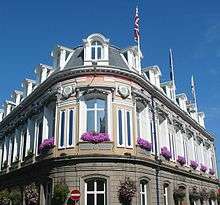
The parish is divided into vingtaines for administrative purposes:
- La Vingtaine de la Ville
- Canton de Bas de la Vingtaine de la Ville
- Canton de Haut de la Vingtaine de la Ville
- La Vingtaine du Rouge Bouillon
- La Vingtaine de Bas du Mont au Prêtre
- La Vingtaine de Haut du Mont au Prêtre
- La Vingtaine du Mont à l'Abbé
- La Vingtaine du Mont Cochon
For electoral purposes, the parish is divided into 4 districts.
- St Helier No. 1 (comprising the Vingtaine de la Ville) elects 3 Deputies
- St Helier No. 2 (comprising the Vingtaine de Bas du Mont au Prêtre and Vingtaine de Haut du Mont au Prêtre) elects 3 Deputies
- St Helier No. 3 (comprising the Vingtaine du Rouge Bouillon and Vingtaine du Mont à l'Abbé)
- St Helier No. 4 (comprising the Vingtaine du Mont Cochon)
- votes from polling stations in Nos. 3 and 4 are combined into one district electing 4 Deputies. This district is the largest constituency in the island.
Honorary Police of St Helier
All parishes of Jersey, including St Helier, have an Honorary Police force.
Politics
With the Constable, the parish therefore has 11 representatives in the States of Jersey (out of 53 elected members).
The Parish also has its own responsibilities and elections to the Municipality of St Helier take place to elect honorary officials who fulfill a variety of roles for Parishioners under the overall control of the Constable, two Procureurs du Bien Public and the Parish Assembly.
Five members of the Roads Committee and ten Roads Inspectors are also elected by parishioners and ensure that the roads of the parish are kept in good repair.
The members of the Assessment Committee are elected to agree the rate chargeable to each property in the Parish.
The Accounts Committee are elected to ensure that the accounts of the Parish represent a 'true and fair view' of the state of the Parish finances in order that the Parish Assembly may rely upon the information to set the Parish Rate.
Elected officials are supported by a paid administration within the Parish.
Saint

Saint Helier is named for Helier (or Helerius), a 6th-century ascetic hermit. The traditional date of his martyrdom is AD 555. His feast day, marked by an annual municipal and ecumenical pilgrimage to the Hermitage, is on 16 July.
Sites of Special Interest
Many places in St Helier have been formally listed as Sites of Special Interest by the Planning and Environment department of Jersey.[8] Not all are mentioned on this page, only those which are most prominent.
Central Market and Beresford Market
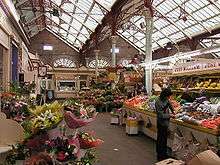
Central Market, in Beresford Street, St Helier, is an indoor market which was opened in 1882.[9] It is an official Site of Special Interest,[10] and is popular with tourists and locals. It features Victorian architecture including cast iron structures, and an ornamental fountain in the centre. The market was designed by Thomas Helliwell of Brighouse, Yorkshire, working with Bellamy and Hardy of Lincoln.[11][12] The market comprises stalls selling flowers, fruit and vegetables, as well as small shops and cafés.
Beresford Market is a separate building next to the Central Market and specialises in fishmongery.[13]
16 New Street
This is an 18th-century Georgian townhouse, with some 19th century additions, which has been renovated by the National Trust for Jersey, and is now operated as a museum.[14][15]
Twin towns and sister cities
Saint Helier is twinned with:
Culture
Saint Helier contains cultural facilities at the Jersey Museum, the Maritime Museum, the Jersey Opera House, the Jersey Arts Centre, the performance venue of St James, the sports and entertainment facilities at Fort Regent, the Jersey Library, the library of La Société Jersiaise and the Jersey Archive.
Sports facilities include Springfield Stadium, swimming pools, pétanque pitches, and badminton. Motor sports events take place on roads in the Parish as well as an annual Town Criterium, and the start and finish of the Jersey Marathon.
The parish has hosted the Jersey Battle of Flowers carnival since 1902.
References
- "Members". Statesassembly.gov.je. Retrieved 4 October 2012.
- Jersey Evening Post, 5 August 2006
- "The Weather in Jersey". Fly Jersey.
- https://www.trevorharley.com/hottest-day-of-each-year-from-1875.html
- https://www.trevorharley.com/1949.html
- "World Weather Information Service - St Helier". May 2011. Retrieved 5 February 2013.
- "Jersey Census 2011" (PDF). Retrieved 4 October 2012.
- "Sites of special interest (SSIs)". Gov.je. 26 July 2012. Retrieved 4 October 2012.
- Parishes
- "Central Market - Flooring". Archived from the original on 25 August 2006.
- Jersey Independent and Daily Telegraph - Saturday 15 May 1880 Pg 2
- "Markets - theislandwiki". www.theislandwiki.org.
- "Jersey Markets Information". Thisisjersey.com. Retrieved 4 October 2012.
- "Historic environment details". Mygov.je. Retrieved 11 October 2012.
- "16 New Street | The National Trust for Jersey". Nationaltrust.je. 26 April 2012. Retrieved 11 October 2012.
- "St Helier 'twinned' with Madeiran capital Funchal". BBC News. Retrieved 4 June 2019.
- "Trenton twinning tourism boost for Jersey?". Jersey Evening Post. 29 November 2019. Retrieved 29 November 2019.
Bibliography
- Balleine's History of Jersey, Marguerite Syvret and Joan Stevens (1998) ISBN 1-86077-065-7.
- Jersey in Figures, 2003–2004, published by the States of Jersey.
